|
|
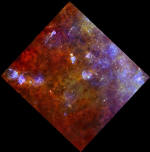
|
|
2012-05-21
The W48 star formation region. PACS 70 microns (blue), 160 (green), SPIRE 250 microns (red) |
|
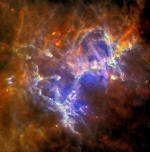
|
|
2012-05-04
Amazing Eagle! The famous Pillars of Creation look very different to Herschel's infrared eye |
|
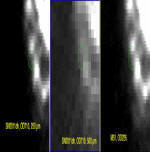
|
|
2012-04-26
Where is Sn2011dh? Despite being bright visually, Herschel does not detect it. |
|
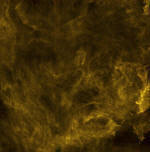
|
|
2012-04-25
Roiling filaments of dust close to Polaris. Dust fills even apparently dark sky. |
|
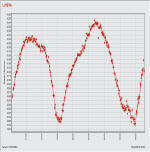
|
|
2010-07-06
The light curve of Rosetta encounter asteroid (21) Lutetia over a full rotation period. The observations were taken by Ramón Naves and Montse Campàs from Montcabre Observatory (Barcelona) on the night of March 15th/16th 2010. The amount of structure in the light curve points to the highly irregular shape of this asteroid. Herschel will observe Lutetia exactly 16 hours (2 rotations) after the Rosetta encounter. |
|
|
|
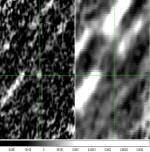
|
|
2010-06-29
Simultaneous images at 70 and 160 microns are placed side-by-side. The pixels at 160 microns are 6".4 in diameter and at this wavelength Herschel is much more sensitive to distant galaxies, hence there are more and brighter trails and less resolution. Although a faint smudge can be seen at the position of Comet Hale-Bopp the expected brightness of the comet at this wavelength is probably too low for it to be detected. |
|
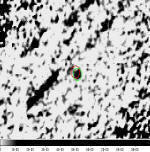
|
|
2010-06-27
This 10.6 hour observation shows Comet Hale-Bopp, now beyond the orbit of Neptune. It was observed by Herschel on Day 392 of the mission - June 10th 2010 - in the 70 micron filter of PACS. Each pixel of the images is 3".2 in diameter. The trails are distant galaxies, some of them possibly as distant as 8000 million light years. This is the deepest image yet with Herschel. At this distance there is no evidence of a coma surrounding the nucleus of the comet. |
|
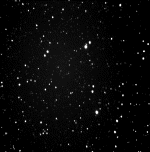
|
|
2010-03-21
2000 - Herschel
Animación realizada con imágenes de Carlos Colazo
Obs. El Gato Gris MPC I19 (Tanti - Argentina), realizadas el 2010-03-20 |
|
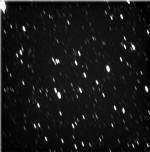
|
|
2010-03-18
2000 - Herschel
Fernando P. Tifner
Obs. Astronómico Beta Orionis MPC I32 |
|
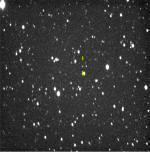
|
|
2010-03-17
2000 - Herschel
Fernando P. Tifner
Obs. Astronómico Beta Orionis MPC I32 |
|
|
|
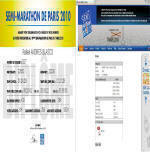
|
|
2010-03-08
Four members of the HSC went to Paris to compete in the 2010 Paris Half Marathon. Rafa Andrés, a software maintenance engineer for HSC finished in a very creditable 439th out of 27 000 participants as his result certificate shows. The team raised money for schools in Burkina Faso. |
|
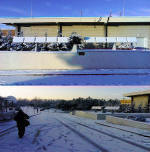
|
|
2010-01-11
As heavy snow falls at the HSC, the Rosetta Team find that Snowlar panels are the solution to space weather!
|
|
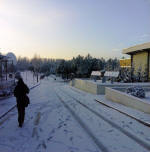
|
|
2010-01-11
As heavy snow falls at the HSC, the Rosetta Team find that Snowlar panels are the solution to space weather!
|
|
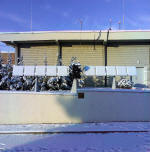
|
|
2010-01-11
As heavy snow falls at the HSC, the Rosetta Team find that Snowlar panels are the solution to space weather!
|
|
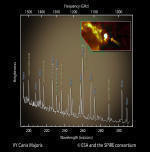
|
|
2009-12-27
Water in the largest known star. Herschel shows that the cloud around this star has so much water that there is as much more compared to the Earth´s oceans as there is in the Earth´s oceans compared to a tea cup.
|
|
|
|
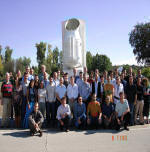
|
|
2009-12-24
Merry Christmas from the HSC Team!! |
|
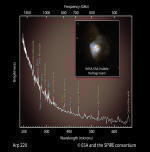
|
|
2009-12-23
SPIRE shows molecules in the peculiar galaxy Arp220 |
|
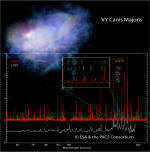
|
|
2009-12-21
Lines galore from PACS in the largest known star: red hypergiant VY Canis Majoris |
|
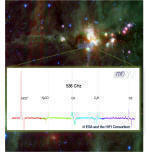
|
|
2009-12-20
HIFI Spectrum of Star-forming region |
|
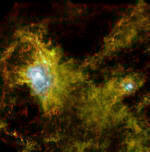
|
|
2009-12-17
Inside the dark heart of the Eagle |
|
|
|
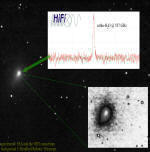
|
|
2009-11-30
Although HIFI has been switched off for some time, even its very early data is spectacular. This is a spectrum of water in C/2008 Q3 (Garradd). |
|
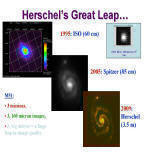
|
|
2009-11-15
A big mirror + state of the art detectors = superb images quality |
|

|
|
2009-11-11
Animación de Herschel
Gustavo Muler
Obs. Nazaret (Lanzarote) - MPC J47 |
|
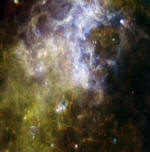
|
|
2009-10-16
Astronomy Picture of the Day
Herschel Views the Milky Way |
|
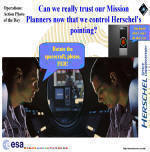
|
|
2009-06-07
With apologies to Stanley Kubrick, Arthur C. Clarke and Fernando Rodríguez (FER):
We now control Herschel, but who controls our Mission Planners?
|
|
|
|
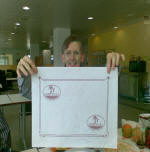
|
|
2009-06-06
How much light pressure is exerted on Herschel's solar panels? Herschel Scientists didn't quite believe the number that we had been told and decided to check it out over lunch. Leo Metcalfe, Herschel Science Operations Manager, proudly shows that we came up with the same answer!
|
|
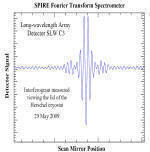
|
|
2009-06-02
The first interferogram the the SPIRE SMEC Fourier Transform Spectrometer. Although it is of the cryostat lid, it shows how well the SPIRE spectrometer is performing in its first tests in space (courtesy: Matt Griffin and the SPIRE Team and Asier Abreu and the HSC Data Processing Team).
|
|
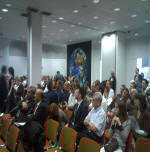
|
|
2009-05-25
Una hora y media antes de lanzar la Sala VIP empieza a llenarse con los miembros de equipo y sus invitados.
An hour and a half before launch the VIP Room starts to fill with team members and their guests.
|
|
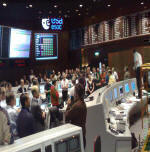
|
|
2009-05-24
El equipo de control de la misión en la sala de control de ESOC en Darmstadt después del lanzamiento. Las consolas de Herschel están a la izquirda de la sala y las de Planck a la derecha.
The Mission Control Team at ESOC in Darmstadt after launch. The herschel consols are to the left of the room and Planck to the right.
|
|
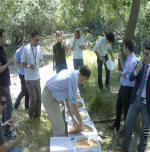
|
|
2009-05-23
La fiesta de las pizzas al lado del río el día antes de lanzar.
The Herschel pizza party on the river bank the day before launch.
|
|
|
|
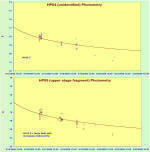
|
|
2009-05-22
Los misteriosos objetos HP04 y HP05 (2009-026E and 2009-026F) que parecen haberse separado de la etapa superior del Ariane poco después de lanzarse, se debilitan deprisa. Se ajusta la curva de luz prevista si reflejan la luz solar desde una superficie constante, cosa que evidentemente no suceda.
The mysterious objects HP04 and HP05 (2009-026E & 2000-026F), which appear to have separated from the Ariane upper stage shortly after launch, are fading rapidly. The expected light curve of they are reflecting sunlight from a constant surface area, something that is obviously not true, is superimposed on the data.
|
|
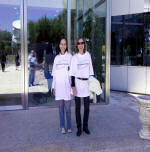
|
|
2009-05-21
Eva y Charo hacen pase de modelos con las camisetas bien ajustadas de Herschel.
Eva and Charo model the nicely fitting Herschel t-shirts.
|
|
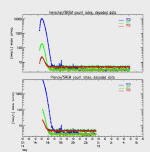
|
|
2009-05-19
Atravesando los cinturones Van Allen. Datos del SREM (Monitor del Entorno de Radiación de la Nave) para Herschel (arriba) y Planck (abajo). El máximo es la travesia del cinturón Van Allen.
Crossing the Van Allen Belts. Data from the SREM (Spacecraft Radiation Environment Monitor) for Herschel (top) and Planck (bottom). The maximum is the radiation belt crossing.
|
|

|
|
2009-05-18
La curva de luz de Herschel a partir de la fotometría de los aficionados. La magnitud absoluta es de 29.2, equivalente a un asteroide con un diámetro entre 3.5 y 8-m (según el albedo).
The light curve of Herschel from amateur photometry. The absolute magnitude is 29.2, equivalent to an asteroid with a diameter between 3.5 and 8-m (depending on the albedo).
|
|
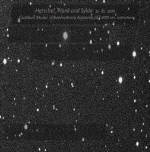
|
|
2009-05-17
De arriba a abajo: Sylda, Plank, Herschel / From top to bottom: Sylda, Planck, Herschel.
Please note that there is some ambiguity between the position of Planck and of the Sylda. |
|
|
|
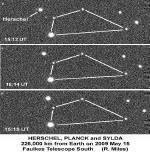
|
|
2009-05-16
Herschel camino a L2 |
|
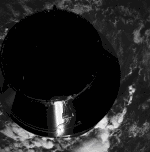
|
|
2009-05-15
Animación de la separación de Herschel de la etapa superior del Ariane. |
|
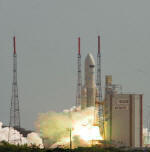
|
|
2009-05-14
Despegue!! |
|
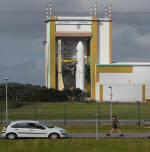
|
|
2009-05-13
Salida del Ariane #188 del edificio de ensamblaje final (BAF) en Kourou
|
|
|





































